Horse tail spine - it roots of the spinal cord, which located in the lumbar region and appearance similar to the tail of a horse. Disruption of the nerve cells in the spine to remove without medical intervention almost impossible.
It is important to diagnose and eliminate the pathology. Damage to nerve fibers is dangerous not only to the development of urinary incontinence or constipation, but also can be a complete loss of sensation in the feet.
As a result, a person loses the ability of independent travel. These diseases are combined in a common group called - cauda equina syndrome.
The content of the article:
- 1 Anatomy and function
- 2 Causes damage to the roots
-
3 Symptoms of the syndrome
- 3.1 pain
- 3.2 sensory disturbances
- 3.3 muscular weakness
- 3.4 Dysfunction of the bladder
- 3.5 Violation of the rectum function
- 3.6 Vegetative-trophic disorders
- 3.7 Disorders of sexual function
- 4 methods of diagnosis
-
5 Treatment of cauda equina syndrome
- 5.1 physiotherapy techniques
- 5.2 Drug disease therapy
- 5.3 Surgery
- 6 Prognosis and complications
- 7 Video of the horse's spine tail
Anatomy and function
Ponytail spine - a kind of beam, consisting of 10 spinal nerve fibers (4 lower lumbar, five sacral and coccygeal) and located in the lower part of the lumbar.
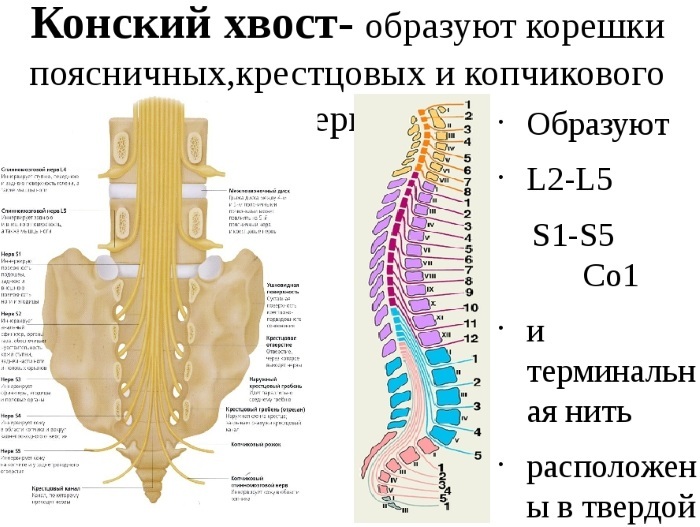
It regulates the activities of the following bodies:
| Name of organs or systems | Is responsible for what ponytail |
| The colon and anal sphincter | Formation and timely evacuation of feces. |
| Organs urinary system | Signals of fullness of the bladder and helps the evacuation of urine. |
| Legs | The sensitivity of the lower limbs and mobility. |
| genitals | Sexual attraction to the opposite sex and erections in men. |
If for any reason there is damage to nerve fibers or destroyed connection therebetween, data organs and systems will not be able to function fully.
Causes damage to the roots
For normal patency of nerve impulses spinal roots must be in the free state. But sometimes, under the influence of external and internal factors, there is a compression, displacement or rupture of nerve fibers. As a result of the activity of the nerve cells of the cauda equina is broken.
Factors causing damage to the roots:
- intervertebral hernia in that area. As a result, suffered a nervous cells. This cause is the most common, which develops as a result of the cauda equina syndrome;
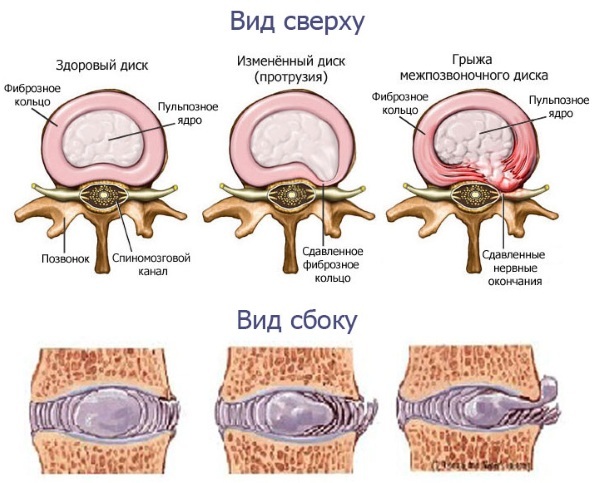
- spinal injury from a fall, gunshot wound or shock. It can occur not only compression but also break the nerve fibers;
- benign or malignant tumor in the spinal cord. A benign tumor may not only was transferred by nerve roots, but also the blood vessels, resulting in deteriorating tissue nutrition. Malignant tumors may also be located near the tissue clamped and further destroy their metastases;
- development of inflammation or infection in the spinal cord;
- abnormalities in the spinal cord, which arose during fetal development;
- complications after medical procedures or surgery;
- severe hemorrhage with hematoma subsequent development;
- abnormal narrowing of the spinal canal;
- prolonged and excessive strain on the spine in this area. As a result of lifting heavy loads, due to incorrect posture or due to the presence of excess weight;
- disturbance of the mobility of the intervertebral discs of cartilage as a result of ossification;
- partial destruction of nerve cells with subsequent replacement of the damaged section of the connective tissue;
- nicotine and alcohol dependence. Toxins which are formed as a result of smoking or alcohol violate the condition of blood vessels, resulting in deteriorated power of the nerve roots;
- sedentary work. Prolonged sitting position blood stagnation occurs in the pelvis, which also affects malnutrition tissue;
- susceptibility at the genetic level.
Physiological factor is a deformity of the spine as a result of age-related changes in the body. It is important for men cauda equina syndrome is more common than in women. In childhood pathology develops only rarely.
Symptoms of the syndrome
Horse tail of the spine may be associated with varying degrees of symptoms. Signs of disease depends on how much damaged roots, in what area and how strong violation.
In this regard, the disease is divided into three forms:
- Easy. Symptoms appear weak. Gradually decreasing intervals between attacks, and signs of increasing. The development of the disease can last up to 6 months.
- Acute. Symptoms appear suddenly and sharply. The disease develops over 3-5 days.
- Chronic. Symptoms appear gradually, then amplified, then subside.
Whatever the form of the disease pathology is accompanied by general symptoms, which are discussed hereinafter.
pain
Violation status roots, regardless of the nature of damage (through, compression or fiber rupture) manifested strong pain. Due to the penetrating, acute pain a person can not change the position of the body. In case of accidental chihe or cough symptom is amplified to unbearable.
Initially, pain is localized to the site of the damaged spine, but may gradually move in the buttocks, legs or groin. If simultaneously with the nerve fibers were hurt muscle tissue, the pain becomes constant aching or pulling character.
sensory disturbances
Due to the conduction of nerve impulses rootlets deterioration, there are disturbances in the sensitivity. This deviation is expressed tingling or burning sensation at the lesion site current, numbness and decreased pain sensitivity of muscle tissue.
Also, the sensitivity of a violation can lead to a change in gait as the patient can not properly control the limbs.
muscular weakness
Defective functioning of the nerve roots leads to disruption of muscle activity. This symptom is expressed initially weak brake. As a result, a person can not overcome long distances, even climbing stairs made with breaks for rest.
In the subsequent disease progression weakness extends to the lower leg and thigh. Man needs a cane or outside help to move. Muscle weakness is more pronounced and rapid progress, if together with the damaged nerve roots located near blood vessels.
The symptom can be expressed not only the deterioration of gait and posture but because the muscles are not able to hold the spine in an upright position for a long time. During examination the expert notes the absence of knee-jerk from the impact hammer.
Dysfunction of the bladder
The roots of the cauda equina are responsible for the normal functioning of the urinary system. When they are damaged at an early stage marked difficulty with urination. Due to the stagnation of urine in the bladder, increasing the risk of infection in the body.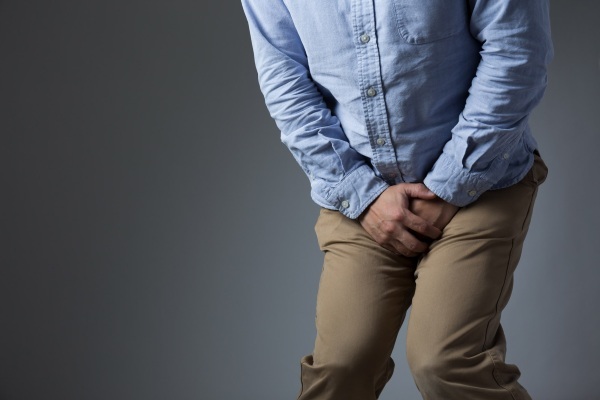
As a result of the cauda equina syndrome may be accompanied by the development of inflammatory processes in the urinary system. In the absence of treatment, the patient no longer control the process output and evolving urine incontinence. Enuresis is further accompanied by a mental disorder, depression.
Violation of the rectum function
Deterioration pulses patency in cauda equina may also be accompanied by a dysfunction of the rectum. Expressed as a symptom of flatulence, infrequent bowel movements. As a result, the body is not released in a timely manner of toxins, which leads to lower immunity and frequent allergies.
For bowel patient must make an effort, despite the fact that the stool is often not formed (in pasty or liquid form). These abnormalities are often the cause of dysbacteriosis development, which is accompanied by constipation or diarrhea. In the absence of therapy, cauda equina syndrome can result in faecal incontinence.
Vegetative-trophic disorders
Disruption of the roots of the cauda equina may further be accompanied by a deterioration of the skin. It expressed symptom bluish epidermis, its high humidity, or peeling skin. In addition, on the legs stop growing hair and nails become brittle. If left untreated, can begin to develop sores.
Disorders of sexual function
The roots of the cauda equina are responsible for the functions of the genital organs. When they are violated in men begins to develop impotence, and women lack of libido and orgasm. With timely examination and treatment functions lend themselves to full restoration.
Additionally, cauda equina syndrome may be accompanied by:
- headaches;

- irregular heartbeat;
- insomnia development;
- depression and increased anxiety;
- regular weak and broken.
It is therefore important, in cases of suspected development of pathology, undergo timely examination and treatment.
methods of diagnosis
Ponytail - this is a bundle of spinal spinal roots. Therefore, disease identification and designation of the method of its elimination, is engaged in a neurologist. Put yourself accurate diagnosis of cauda equina syndrome is impossible.
Examination by a specialist includes the following steps:
1. Collecting complaints from the patient's words:
- Specialist identifies that were marked deviations, and how they are expressed;
- whether there is a genetic predisposition;
- clarifies the professional activity;
- Whether made in recent times medical manipulations in the art;
- whether and when spinal injury;
- whether urination and defecation process problems.
2. Medical examination:
- check knee-jerk;
- Assessment of the skin;
- checks posture;
- if necessary, the doctor may require to perform sit-ups, running in place, to identify the changed state patient or not (new or increased pain), as well as to determine how quickly the patient tired limbs.
3. Analyzes. Surrender, stool, urine and blood is required to eliminate the infection in the body, including the bladder and to eliminate dysbiosis development. In addition, the expert assesses the general state of the immune system.
4. Hardware Survey. This item is required to identify the cauda equina syndrome. Since you want to define on which part of the damage occurred spine, a number of nerve fibers affected and how severely compromised activity. The hardware survey included:
-
Radiography. The survey is performed using X-rays. The procedure allows to detect the presence of changes in the state of the spine, including the narrowing of the intervertebral space, and the degree of compression of the roots;

- CT scan. CT allows more qualitatively inspect the state of the spine (narrowing, tampering) and detect birth defects in bone. But it does not allow to identify tumors as poorly visualises soft tissue;
- Magnetic resonance imaging. MRI is used to identify benign or malignant tumors, hematoma, since in contrast to CT better visualize soft tissue instead of bone. Therefore, for a more accurate diagnosis and recommended to undergo CT, and MRI.
- Myelography. The procedure is performed using X-ray and contrasting agent. It allows you not only to identify a violation of the state of the roots of the cauda equina, but also determine the level of pressure that is on them;
- A lumbar puncture. The survey is to fence the cerebrospinal fluid. If it contains blood, it indicates the presence of a hematoma or hemorrhage. If the fluid is increased protein content, it is a sign of cancer. In the presence of inflammation or infection in the liquid contained an increased amount of lymphocytes and leukocytes. If liquid when the fence is missing, this may indicate the development of a tumor or hernia, which blocked the passage for the CSF;
- Histological fence. Produced tissue sampling to identify the extent of the detected tumors danger.
Sometimes for a full diagnosis requires passing all points of surveys, including hardware.
Treatment of cauda equina syndrome
Horse tail spine amenable to medical treatment only at the initial stage of disease development. If the disease is started, it requires surgery. Medical or surgical treatment is required to conduct concurrently with physical therapy.
physiotherapy techniques
Physical therapy may be used as the prevention of a pathology, as well as procedures can reduce pain and improve circulation after surgery and during the reception medicines.
The most popular are the following physiotherapy: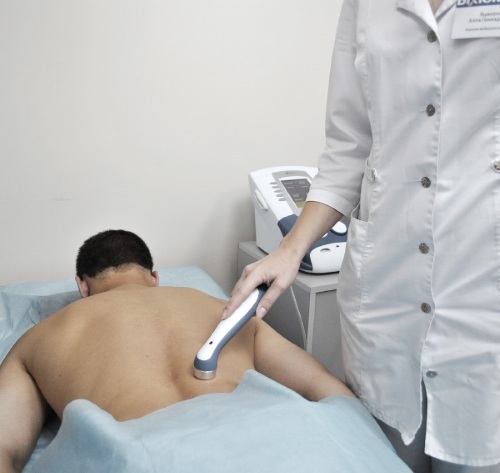
| Name treatments | The method | Why is appointed |
| Ultra- or electrophoresis | Using ultrasound or micro-injection of medications is made subcutaneously. Used primarily analgesics. | The method can reduce the pain at the site of the defeat of roots. When this drug enters directly into the affected area, without irritating the organs of the digestive tract. |
| UHF and diadynamic currents | At the lower part of the UHF lumbar region affect high-frequency electromagnetic field. When Diadynamic method on cauda equina impact zone constant low pulse currents. | Procedures allow you to restore and enhance the blood circulation in the cauda equina area. As a result, a rebuild process is accelerated tissue. |
| Laser therapy | The procedure is performed using laser beams of a certain length. | The method allows to intensify the process of tissue repair, and also improves blood circulation in the processing zone. |
| magnetotherapy | On the cauda equina zone (around the spine can) affect constant or alternating magnetic field. | The procedure restores the metabolic processes in the tissues, accelerates cell regeneration and normalizes blood circulation. |
In addition, it can be assigned to treatments with mineral waters, curative mud and paraffin applications. They also restore blood circulation and accelerate the healing process.
Drug disease therapy
Drug therapy is the use of orally administered medications, topically or by injection.
For oral administration, prescribers:
- analgesics (Ketanov, Diprospan or Baralgin);
- vitamin complexes with increased vitamin content;
- to restore vascular patency and condition (Trental, Detraleks, Cinnarizine).
For topical application are used:
- Painkillers (Ketonal, Fastum gel debt). These ointments simultaneously reduced blood circulation in the area of application and reduces muscle tonus.
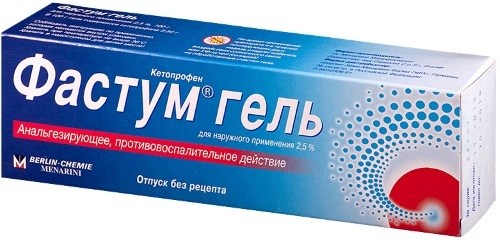
appointed for injection:
- analgesics (Ortofen, Neyrobion, Oksadol);
- to restore blood flow (Vepramil, Amlodipine, Prazonin).
antibiotics or antiviral drugs (Amoxicillin, Viferon, Sumamed) may be assigned to the presence of infection. They can also be assigned to preparations for the restoration of urination and defecation process. All medicines are selected by the attending specialist with regard to their compatibility, as well as contraindications to the patient.
Surgery
If damage to the roots of the cauda equina tumor caused by the presence, herniated vertebral or spinal injury, surgery is assigned. In some cases, you may need to install the implants.
Types of possible operations:
- discectomy. The doctor produces removing the intervertebral disc;
- laminectomy. The surgeon removes part of the vertebra;
- neurolysis. Using surgical manipulations specialist produces the release of the compressed fibers.
Also, by the operation performed removing hematoma and tumor entities that violate the functioning roots.
Prognosis and complications
Horse tail spine is mostly acquired disease so the development of this disease can be prevented.
This requires:
- if there is a predisposition of cauda equina syndrome, is required once a year to be screened by a neurologist;
- stop smoking, alcohol;
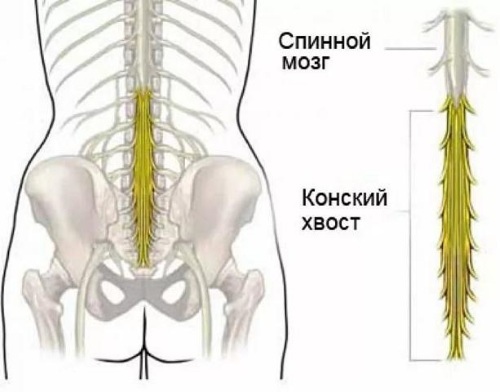
- exclude a sedentary lifestyle;
- in the presence of intervertebral hernias produce timely therapy;
- adherence to a balanced diet;
- Avoid games and other activities that may be associated with spinal cord injuries;
- if there is pain, causeless development of constipation or other characteristic of the appearance of symptoms is required to pass a timely examination by a specialist.
Additionally recommended once a quarter held classes in physical therapy office.
If the disease is detected and confirmed by a specialist, but the treatment is not available, it is possible to develop the following complications:
- development of impotence;
- incontinence of urine or feces;
- deterioration in gait;
- immobilization of the lower extremities.
With timely treatment, provided that the disease is not caused by severe trauma, you can completely restore the activity of the roots of the cauda equina. But subsequently recommended to avoid factors that trigger the disease development (Obesity, sedentary lifestyle, spine trauma associated with professional activities).
Ponytail is localized in the lower part of the spine and regulates the activity of the intestines, urinary and lower extremities. Therefore, the pathology associated with impaired activity of this part of the spine may be accompanied by a failure in the functioning of these organs and systems. It is important that men over 40 likely to develop disease - cauda equina syndrome.
Author: Svetlana Kotlyachkova
Registration of the article: Vladimir the Great
Video of the horse's spine tail
Malyshev of cauda equina syndrome:



